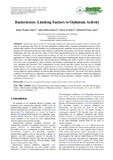| dc.contributor.author | Maina, Juliana Wanjiru | |
| dc.contributor.author | Mathara, Julius Maina | |
| dc.contributor.author | Kikuvi, Gideon M. | |
| dc.contributor.author | Ouma, Shellemiah Otieno | |
| dc.date.accessioned | 2017-10-05T09:28:15Z | |
| dc.date.available | 2017-10-05T09:28:15Z | |
| dc.date.issued | 2017 | |
| dc.identifier.citation | Journal of Food Security, vol. 5, no. 2 (2017): | en_US |
| dc.identifier.uri | http://hdl.handle.net/123456789/2835 | |
| dc.identifier.uri | http://pubs.sciepub.com/jfs/5/2/1/index.html | |
| dc.description | DOI:10.12691/jfs-5-2-1 | en_US |
| dc.description.abstract | Bacteriocins are described as ribosomally synthesized antimicrobial peptides lethal to bacteria other than the producing strain. They are the most abundant of antimicrobial compounds produced by bacteria. These antimicrobial peptides offer an advantage over by targeting specific organisms and are generally regarded as safe for humans. The crude bacteriocins have been found to be affected by the presence of proteolytic enzymes like trypsin, temperature, pH, salts, and ions like copper or iron. These antimicrobial agents are gaining attention not only as alternative therapeutics in the pharmaceutical industry but also as a bio-preservative in food industries and in agriculture for control of bovine mastitis pathogens. These applications fundamentally depend on their antimicrobial effects and a vast understanding of their activity and factors inhibiting their mode of action. In this review factors perceived to be consequential to either activating, inactivating or maintaining the optimal activity of bacteriocins were identified and discussed. This comprehensive review delved into these factors with the aim of in-depth understanding of bacteriocins and their application for extensive exploitation. The remits of this detailed review include aspects of re-assuring public faith in bacteriocins and providing adequate information to users on their activity under the various condition in order to make informed choices before use. This review will help in restoring confidence in bacteriocins as a substitute to conventional antibiotics presents a considerable commercial challenge to the pharmaceutical industry. This indulgence will help develop innovative strategies towards the industrial application of bacteriocins. | en_US |
| dc.language.iso | en | en_US |
| dc.publisher | Science and Education Publishing | en_US |
| dc.subject | bacteriocins | en_US |
| dc.subject | antimicrobial peptides | en_US |
| dc.subject | antimicrobial activity | en_US |
| dc.subject | bacteriocidal spectrum | en_US |
| dc.title | Bacteriocins: Limiting Factors to Optimum Activity | en_US |
| dc.type | Article | en_US |

